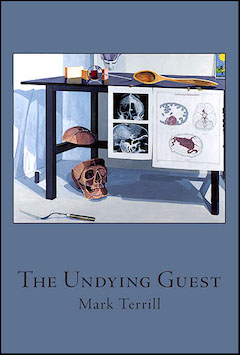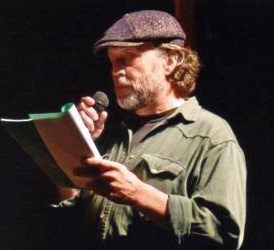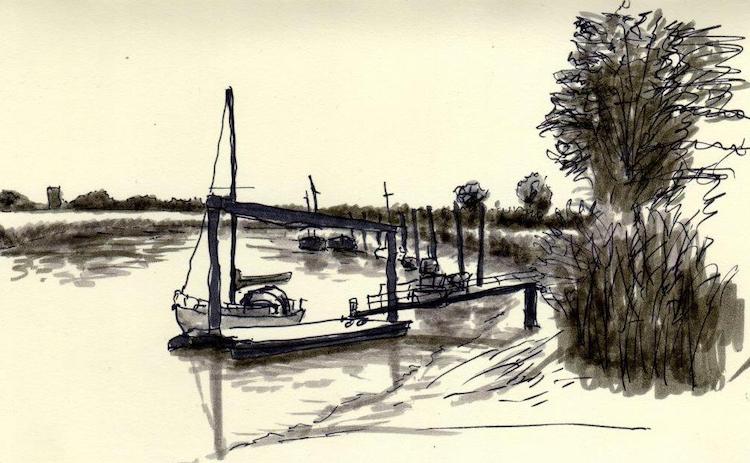
Mark Terrill’s latest book, The Undying Guest, fits gemlike and exquisite in the palm of your hand. Yet it spreads like a flower deep in your head. Probing daily life for meaning in far-flung places from Hamburg to Yokohama, this sea-going, globe-trotting author is a roving poet with a painter’s eye and a phenomenological turn of mind. If it’s possible to be Kerouacian without the mawkishness and Baudelaireian without the derision, Terrill is both.
To make my point, here is PARIS-MACBETH VORTEX, one of 60 prose poems in this collection:
The slightest purpose with its featherweight resolve has me going down the rue Lacépède from the place de la Contrescarpe toward the Jardin des Plantes for a leisurely walk in the park & halfway down the hill I see two grubby red-faced winos in a little corner niche between two buildings which provides just enough shelter for the two of them & their meager belongings & my passing cursory glance becomes a prolonged study as I walk by looking closely yet discreetly at how they’re living right there on the street amid the empty bottles & rubbish & dirty blankets grumbling & muttering & puttering about in their squalid domesticated oblivious anarchy which catches me up in a vortex of conflicting emotions repelled as I am at the filth & neglect but simultaneously sympathetic toward their plight & finally almost sort of envious at the display of such resolute stoicism & overall psychic immunity in the face of such otherwise hopeless odds making me think of that scene in Macbeth where Banquo comes out of the castle with his son & makes a passing remark to the men outside about the impending rain only to be answered by the flash of a blade & the admirable four-word sentence so succinct & brutal: ‘Let it come down’ which of course meant the end of Banquo but also implied something of the fatalistic going-with-the-flow-of-things & spiritual resilience which I could stand to cultivate myself if I wasn’t always so caught up in the endless play of appearances & the spectacular imagery while walking down the street in Paris just ghosting along through the thick of it all.
As I was reading through the book, I began to wonder who “the undying guest” is. And I began to think it might be the poet. Here’s why:
THE UNDYING GUEST
You die again & you’re born again & this time around you’re the Undying Guest in a room with a hot plate upstairs in back in the Palace of Birth & Death from where you look down at the expansive gardens & early trimmed lawn & see the gardener standing by the idling lawn mower trying to decide whether to mow the lawn in parallel swaths or concentric circles as though it was the only game in town & as much as you are able to enjoy being exempt from the contingencies of Time which for the Undying Guest is neither linear nor analog neither finite nor infinite it is not without a certain pang of nostalgia that you watch the gardener standing there caught up in his cloud of ambiguity & indecision like the cloud of nauseating exhaust fumes spewing from the sputtering lawn mower as you remember how it used to be when life was an unbound narrative & closure was its editor & carbon monoxide was something you had to be afraid of & not just a pretty shade of blue hovering there above the deep emerald green of the soon-to-be-mown lawn.
Terrill once sent me some of his landscape sketches, simple black-and-white drawings. He makes no claims for them. He does them simply for the pleasure of drawing.
I presume his enjoyment is an inheritance from his mother, the artist Ruth Terrill (1930-2023), one of whose paintings illustrates the book cover. And I believe a comment she made about her art would also describe his poems. (For the seaman he’s been I’ve changed her “struggle” to his “voyage”.)
My work is based on my interest in existential and metaphysical ideas. It is a reflection of my life long voyagestruggleto understand the meaning of life and death. In other words, my art is central to my spiritual search.”
Blurbs usually don’t mean much. But Stephan Delbos has written a serious exception:
This is real-time poetry, in which the events and thought processes described unfold in the same interval it takes to read about them The result is a collection of meticulously recorded observations in which scenery serves to direct a quicksilver flow of associate thought … perfect blocks of text which seem to have been grafted from the nebulous atmosphere of thought, pressurized and framed on the page.”







What a fine delicate drawing. If seeing is believing in this drawing I believe what I see and it is truly a lovely drawing far beyond words that little boat can go!
wonderful when a man of Terrill’s class rekindles the barbizon plein air tradition
yes make it new as old £ insisted.
thanks for this great posting.
GB
both comments much appreciated.